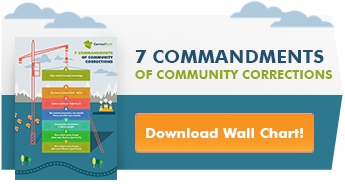
Key Takeaways:
- Digital systems cut paperwork and improve team collaboration.
- Paperless tools strengthen compliance with accurate records and easy audits.
- Going digital saves time, reduces costs, and improves client engagement.
Paperwork has long been part of the community corrections process. From case files and supervision plans to compliance reports and audit documentation, the volume of paper can quickly overwhelm even the most organized teams. But with today’s technology, paper no longer needs to be the standard.
Going paperless can help your agency overcome many of the everyday frustrations that come with managing large amounts of documentation. Digital tools offer centralized data, real-time updates, and easier collaboration, helping your team work more efficiently and stay focused on client needs.
CorrectTech’s software solutions give community corrections agencies the power to move beyond paper and into a more effective way of working. Let’s look at the key benefits of switching to a digital-first approach.
1. Streamlined case management
Paper files used to be the only way to manage case information. But today, paper-based systems can slow your team down, introduce unnecessary risk, and waste valuable time. When every document lives in a different place, small mistakes can quickly snowball into bigger issues. That’s where modern digital case management changes everything.
Here’s what you can expect when your agency upgrades to a centralized digital system:
- All client records in one place: From case plans to contact notes, everything your team needs is just a few clicks away.
- Quick, reliable access to information: No more digging through stacks of paper or chasing down lost files.
- Smart task management: Built-in alerts and automated workflows help your team stay organized and on track.
- Top-tier data security: Keep sensitive records safe with encrypted storage and controlled access.
Embracing digital technology is a smarter way to work. With the right tools, your team can spend less time managing paperwork and more time making a difference.
2. Better communication with clients and teams
Clear, timely communication can make all the difference in community corrections work. Digital platforms help teams deliver updates, reminders, and messages without adding extra work. Whether it’s confirming an appointment or sending a quick check-in message, staff can reach clients directly and securely through the system.
Digital tools also support team communication by eliminating the need to pass along information manually. With shared digital notes and live status updates, staff members can step in to support a client without missing a beat. This reduces miscommunication and helps the entire team stay in sync, no matter who’s on shift.
In addition to helping staff stay connected, these tools give justice-involved individuals better visibility into their own responsibilities. Automated reminders, digital forms, and remote check-in options make it easier for them to stay engaged and compliant, building trust and keeping their progress on track.
3. Improved compliance and documentation
Paper records leave too much to chance. A missing file, an incomplete note, or a forgotten timestamp can make or break compliance efforts. Moving to a digital documentation system ensures nothing slips through the cracks, protecting your agency and strengthening your accountability.
Here’s what a digital-first approach brings to your documentation process:
- Complete, organized records: Store everything securely, with no risk of files getting lost or damaged.
- Automatic date and time tracking: Every action is logged, giving you a clear timeline for every case.
- Reduced human error: Digital forms help staff capture all required information, every time.
- Easy audit readiness: Searchable records make it simple to respond to audits or data requests.
When your records are accurate and complete, your team can focus on delivering services, not scrambling to fill gaps when an audit arrives.
4. Data-driven decision making
In a fast-paced environment, having the right information at the right time makes all the difference. Digital tools give community corrections agencies access to real-time data that can be used to strengthen services, track progress, and demonstrate impact. This helps leadership make decisions based on facts, not assumptions.
Here’s how a paperless approach supports better data-driven management:
- Real-time dashboards: Quickly see what's working and where adjustments are needed.
- Client outcome tracking: Measure how services are impacting individuals and program goals.
- Data exports and reports: Share meaningful insights with oversight agencies or community partners.
- Resource utilization reports: See how staff time and agency resources are being used.
- Strategic planning tools: Use data to guide future planning and program development.
With data at your fingertips, your agency can lead with confidence and back decisions with measurable results.
5. Cost and resource savings
Paper-based systems might seem affordable at first glance, but the actual cost adds up quickly. Agencies spend thousands each year on paper, printing, filing supplies, and storage space. In addition, staff time is wasted on managing physical files, and the long-term expense becomes even harder to ignore. Digital systems eliminate these ongoing costs, freeing up your budget for what really matters—client services.
By cutting down on paper, reducing administrative hours, and minimizing physical storage needs, your agency can redirect resources toward improving programs and outcomes. Digital tools also make it easier to scale operations without increasing overhead.
What agencies want to know before going paperless
Making the switch to digital can feel like a big step, especially if your agency has used paper-based processes for years. To help you navigate the transition, here are answers to five common questions community corrections teams often ask.
Is it expensive to implement a digital system?
While there is an upfront investment, most agencies find they save money over time by reducing spending on paper, printing, storage, and administrative hours. Digital systems often prove to be more cost-effective in the long run.
How long does the transition take?
The timeline depends on your agency’s size, staffing, and technology needs. Many agencies choose to roll out digital tools in phases, starting with one area and expanding as staff gain confidence with the new system.
Will staff lose access to historical paper records?
No. Existing records can typically be scanned, digitized, or referenced alongside the new system. This ensures that staff continue to have access to the full history of client information as needed.
Can the system be accessed remotely?
Most modern digital platforms include secure remote access. This allows staff working in the field, at different locations, or on different shifts to stay connected and up to date on client activity.
Who can help if something goes wrong?
Agencies should look for a digital solution that includes ongoing technical support and system maintenance. Reliable customer service ensures that your team has help available when needed, minimizing disruptions to your work.
Digital systems move community corrections forward
Paper-heavy processes make it harder for community corrections teams to keep up with growing demands. From case management to compliance and client communication, digital systems offer a better way to work. Going paperless strengthens both operations and outcomes by reducing paperwork, improving recordkeeping, and helping teams stay connected.
CorrectTech helps agencies achieve these goals with software built for real-world community corrections challenges. If you’re ready to reduce the paperwork and focus more on people, now is the perfect time to make the switch.


